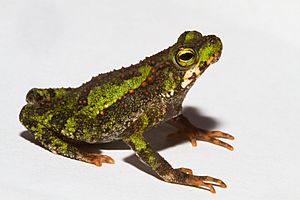Incilius facts for kids
Incilius is a group of toads, also known as the Central American toads or Middle American toads. These toads belong to the true toad family, called Bufonidae. You can find them in the southern parts of the USA, Mexico, Central America, and the northern Pacific areas of South America (like Colombia and Ecuador).
These toads live in many different places. Some, like Incilius spiculatus, are very rare and only live in special places like undisturbed cloud forests. Others, like Incilius valliceps, are more common and can be found in many different habitats, even places changed by humans.
Quick facts for kids Incilius |
|
|---|---|
 |
|
| Incilius coniferus is the type species of genus Incilius | |
| Scientific classification |
|
| Kingdom: | Animalia |
| Phylum: | Chordata |
| Class: | Amphibia |
| Order: | Anura |
| Family: | Bufonidae |
| Genus: | Incilius Cope, 1863 |
| Type species | |
| Bufo coniferus Cope, 1862
|
|
| Synonyms | |
|
Cranopsis Cope, 1875 "1876" (junior homonym of Cranopsis Adams, 1860 (Mollusca) and Cranopsis Dall, 1871 (Brachiopoda)) |
|
Contents
Understanding Incilius Toads
Scientists group living things into categories like genus and species. This helps them organize and study different animals. The genus Incilius is a group of toads that share many similar features.
How Scientists Name Toads
The genus Incilius was first named in 1863 by a scientist named Edward Drinker Cope. He chose Incilius coniferus as the main example, or type species, for this group. For a long time after that, these toads were often placed in a different genus called Bufo.
However, in the early 2000s, scientists started looking more closely at these toads. They found new evidence that showed Incilius should be its own separate genus again. This means that many toads once called Bufo are now called Incilius.
Changes in Toad Classification
Naming and classifying animals can be tricky! Scientists are always learning new things. For example, the toad I. coniferus had its name changed about five times in just a few years. This shows how much scientists work to get the classifications right.
In 2011, a group of scientists led by Mendelson made some important changes. They confirmed that several other toad groups, like Cranopsis and Crepidius, were actually part of Incilius. They also showed that another group, Rhinella, was different from Incilius.
Sometimes, scientists also discuss if Incilius should be a full genus or just a smaller group (a subgenus) within Bufo. But for now, most scientists agree that Incilius is its own genus.
Types of Incilius Toads
There are currently 39 known species (types) of Incilius toads. Each species has its own unique features.
- Incilius alvarius (Girard, 1859)
- Incilius aucoinae (O'Neill and Mendelson, 2004)
- Incilius aurarius Mendelson, Mulcahy, Snell, Acevedo, and Campbell, 2012
- Incilius bocourti (Brocchi, 1877)
- Incilius campbelli (Mendelson, 1994)
- Incilius canaliferus (Cope, 1877)
- Incilius cavifrons (Firschein, 1950)
- Incilius chompipe (Vaughan and Mendelson, 2007)
- Incilius coccifer (Cope, 1866)
- Incilius coniferus (Cope, 1862)
- Incilius cristatus (Wiegmann, 1833)
- Incilius cycladen (Lynch and Smith, 1966)
- Incilius epioticus (Cope, 1875)
- Incilius fastidiosus (Cope, 1875)
- Incilius gemmifer (Taylor, 1940)
- Incilius guanacaste (Vaughan and Mendelson, 2007)
- Incilius holdridgei (Taylor, 1952)
- Incilius ibarrai (Stuart, 1954)
- Incilius karenlipsae Mendelson and Mulcahy, 2010
- Incilius leucomyos (McCranie and Wilson, 2000)
- Incilius luetkenii (Boulenger, 1891)
- Incilius macrocristatus (Firschein and Smith, 1957)
- Incilius majordomus Savage, Ugarte, and Donnelly, 2013
- Incilius marmoreus (Wiegmann, 1833)
- Incilius mazatlanensis (Taylor, 1940)
- Incilius mccoyi Santos-Barrera and Flores-Villela, 2011
- Incilius melanochlorus (Cope, 1877)
- Incilius nebulifer (Girard, 1854)
- Incilius occidentalis (Camerano, 1879)
- †Incilius periglenes (Savage, 1967)
- Incilius peripatetes (Savage, 1972)
- Incilius perplexus (Taylor, 1943)
- Incilius pisinnus (Mendelson, Williams, Sheil, and Mulcahy, 2005)
- Incilius porteri (Mendelson, Williams, Sheil, and Mulcahy, 2005)
- Incilius signifer (Mendelson, Williams, Sheil, and Mulcahy, 2005)
- Incilius spiculatus (Mendelson, 1997)
- Incilius tacanensis (Smith, 1952)
- Incilius tutelarius (Mendelson, 1997)
- Incilius valliceps (Wiegmann, 1833)
Sometimes, different scientific groups have slightly different lists. For example, the AmphibiaWeb website lists Incilius intermedius as a valid species. However, another group, Amphibian Species of the World, thinks it's the same as Incilius occidentalis. This shows that science is always growing and changing!
See also
 In Spanish: Incilius para niños
In Spanish: Incilius para niños

